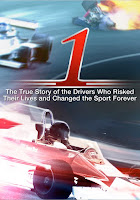A film review by
Richard Roeper, Movie Columnist, September 26, 2013.
In the
individual sports, it’s nearly impossible to become a champion for the ages if
you don’t have a fierce and lengthy rivalry with an opponent of near or equal
skill and heart. Jack Nicklaus needed Arnold Palmer. Muhammad Ali needed Joe
Frazier. Nadal/Federer, Hagler/Hearns, Earnhardt/Waltrip, Duran/Leonard...
And in
the 1970s on the Formula One racing circuit, it was Niki Lauda vs. James Hunt.
They needed each other.
Even if
you don’t know Formula One from the Soap Box Derby, Ron Howard’s Rush, like
all great sports movies inspired by true events, is foremost about getting to
know and understand the characters. By the time we get to the inevitable Big
Game/Race/Match, the stakes are so high and the drama so real we find ourselves
tensing up — even though we’re watching a re-creation of events long since in
the record books.
Rush ranks among the best movies about
auto racing ever made, featuring two great performances from the leads, who
capture not only the physical look of the racing legends they’re playing, but
the vastly different character traits that made their rivalry, well, made for
the movies.
At first
blush the brusque, detail-obsessed, virtually emotion-free Austrian Lauda (Daniel Bruhl) and the cocky,
womanizing, partying Brit Hunt (Chris
Hemsworth, his blond locks only slightly shorter than Thor’s) are such
polar opposites they make Rocky Balboa and Apollo Creed seem like kindred
spirits. But as we follow their rivalry from the stepping-stone Formula Three
circuit to the big stage of Formula One, we see there’s more to Lauda than his
relentless quest for perfection, while Hunt learns the hard way he’s not immune
to heartbreak — and he uses that pain to dedicate himself to the world
championship.
Lauda’s a perfectionist in the garage, tirelessly
working to build a better machine. Hunt figures he’ll floor it when you’re
easing off on a turn and he’ll roar past you. When Lauda proposes to his girl Marlene (Alexandra Maria Lara), he says he’ll
probably forget her birthday and he’s not much for holding hands, but if I’m going to do this with someone, it
might as well be you. Hunt also gets married, but he proposes to supermodel
Suzy Miller (Olivia Wilde) because
they’re two of the best-looking and most fabulous people on the planet, so why
not go for the fairy tale? (Even when the marriage falls apart, it’s in
spectacular fashion. Richard Burton steals Suzy while James is brooding and
boozing over his stalled racing career.)
Director Howard expertly sprinkles in the domestic
scenes while giving us just enough inside
baseball sequences to familiarize the non-fan with Formula One racing
without getting bogged down in the detail. The terrific script by the great Peter Morgan (The Queen, Frost/Nixon, The Last King of Scotland) keys in on what
makes these men risk their lives every day when they go to work — and then we
get another cool, 1970s graphic establishing the next European or South
American or Asian stop on the 1976 circuit. (Rush is rated R, and it should be. If you’re going to show the
horrific crashes, not to mention Hunt boffing his way through half the
stewardesses, models and groupies of the time, you can’t just hint at it.)
As Hunt puts it, these Ferraris and McLarens are
coffins sitting on high-octane fuel. And though Hunt’s the risk-taker, it’s
Lauda who winds up in the hospital, his face horribly burned, his lungs so
filled with soot and smoke they have to be vacuumed
via a long tube inserted into Lauda’s mouth — while he’s conscious. Less than
two months later, Lauda is back in action, against all medical advice. He’s not
about to let Hunt take away his title by piling up the points while he’s
sidelined. Lauda needs Hunt. Hunt needs Lauda.
Chris Hemsworth is so comic-book handsome it takes
a while to realize what a fully realized performance he’s giving, playing a guy
who loved the celebration as much as he craved finishing first. Hunt isn’t some
empty-headed himbo. He loves racing because it makes him feel like a modern-day
knight.
As for Bruhl’s work as Niki Lauda: This is
nomination-level acting. The Austrian perfectionist role could have been the
stuff of caricature — and indeed Lauda gets most of the laughs in the movie by
virtue of his near total lack of social graces. But we also see flickers of
playfulness in Lauda’s eyes during a hilarious hitchhiking scene that winds up
with him behind the wheel in the Italian countryside, much to the rapture of
two fans in the back seat. Bruhl is also magnificent conveying Niki’s maddeningly
analytical philosophy (Happiness is the
enemy, because when you’re happy you have something to lose) and his
relentless determination.
Ron Howard has an Oscar and he’s been one of our
best storytellers for 30 years. This is one of his most impressive efforts,
with an edgy, kind of Euro feel,
especially in the harrowing racing sequences.
Real-life spoiler alert: Niki Lauda passed away in May, 2019 at age 70.
James Hunt is long gone. Mr. Lauda had expressed his regrets Mr. Hunt
wouldn’t be able to experience Rush.
It would have been great to see them see it
together.
Email: rroeper@suntimes.com
Labels:
action, auto-racing, biography, drama, Ferrari, history, romance, rom-drama-faves, sport






